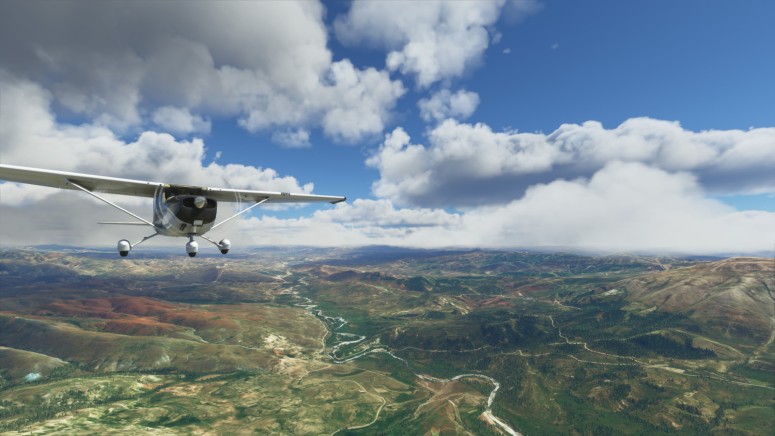
Microsoft Flight Simulator – A Quick Review of the Most Advanced Flight Sim Ever Released
Asobo’s Microsoft Flight Simulator can be considered a handful of technological breakthroughs packed into a single product. The game area is a 1:1 representation of the entire Earth, the weather system is using real-world data to simulate accurate flying conditions, and artificial intelligence is used to render buildings and trees on the fly, using high-resolution satellite imagery.
However, this is still a flight simulator, which means that the absolute most you can do is sit in a plane and watch the scenery go by for hours on end. Naturally, that is exactly what enthusiasts and hardcore flight simmers want, but why is everyone else so hyped about this game?
In truth, it’s probably the novelty factor, and the fact that you can (probably) fly over your own house. Having the whole world to your disposal is not something that you can get in any other game at the moment, so it’s only natural that people are flocking to this title to see what all the fuss is about.
In spite of that, Microsoft Flight Simulator is still going to be responsible for a whole new generation of flight sim enthusiasts. Sure, most casual gamers will get bored of it after a few weeks, but the truth is that this game was not really meant for them anyway. If the past is anything to go by, this game will continue to be the go-to simulator for over a decade, and it’s only going to get better with time.
1:1 World Map Using Bing Maps
Let’s talk about the game world first, because that’s what everyone seems to be most impressed by - and with good reason. Microsoft Flight Simulator is indeed offering a faithful recreation of the entire Earth, complete with mountains, rivers, cities, forests, and roads. However, except for a few well-known landmarks, everything was generated automatically instead of being modeled by artists in the traditional way.
The foundation for all of this is Bing Maps, which is Microsoft’s alternative to Google Maps. In short, Microsoft imaged the whole planet using satellites and low-flying airplanes, then used this data to recreate the Earth in Microsoft Flight Simulator. Obviously, this was not the initial goal behind Bing Maps, but it turned out to be a very cool tool for a flight sim.
The image quality varies depending on location since it is clearly not possible to capture high-resolution photos of isolated or inhospitable places. Hence, while places like Antarctica, Greenland, and various islands in the Pacific are still present in the game, they are not nearly as detailed as what you get in Europe, Asia, and the United States.
2 Petabytes of Game Data Stored in the Cloud
If you know anything about video games, you might be wondering how is it possible to have the complete world map and all those high-resolution textures on your PC. Well, it is not stored on your hard drive since no one has 2 Petabytes-worth of storage lying around.
Instead, Microsoft hosts most of this data on its Azure infrastructure, and you have to constantly stream assets while playing in order to populate the game world. This is also the reason why it is pretty much impossible to play the game offline - and that’s ignoring the fact that playing offline will also disable your access to live weather and air traffic.
On the other hand, this is the only solution to this problem, since there is no way all that data can be packed into a regular game installer. The good news is that MFS allows you to set data limits from the Settings menu in case you are stuck with a metered connection. Otherwise, you would quickly blow through your allotted bandwidth in just a couple of hours.
Real-Time Weather Almost Anywhere on the Planet
This feature is probably the second most impressive thing about the new Flight Simulator, mainly because the in-game graphics and weather system are beyond gorgeous. The game uses real-time data from weather stations all over the world in order to present you with accurate conditions no matter where you are on the planet, which makes the experience that much more immersive.
The real weather system was showcased in all its glory during hurricane Laura a few weeks ago when thousands of flight simmers started posting screenshots of the in-game storm. Unlike the real thing, you can actually fly through a hurricane in MFS, which is both wonderful and terrifying at the same time.
Alas, there are also problems with the weather system, the most annoying of which is the fact that it doesn’t always work for everyone. This is especially true for US territories at the moment, although there have been some issues around Europe as well. It seems like the game defaults to clear skies when it fails to acquire data from the server, and it’s been happening a lot recently.
If you are not interested in real weather, you can also manually control the conditions while flying, and it’s actually surprisingly easy to do so. You can instantly switch from a few scattered clouds to a raging storm and even add a snow layer anywhere in the world. The time of day can also be controlled using a slider, which makes for gorgeous sunset/sunrise screenshots.
AI-Generated Buildings Thanks to Blackshark.ai
As mentioned before, not everything in Microsoft Flight Simulator is photorealistic. There is only so much a simple high-resolution photo can do when it comes to buildings and cities, not to mention the fact that it’s still only two-dimensional. So what happens if you decide to get really low and take a closer look at the scenery?
This is where Blackshark’s technology comes into play. Their technology was used to automatically generate 3D objects from photos, and it works surprisingly well. The buildings are obviously not super detailed in terms of polygons or textures, but they look convincing enough in most cases.
In addition, the AI is also basing the resulting 3D models on the actual photos, so you should be able to recognize some of them if everything works as intended. Most of the time, the building colors are also preserved, which makes them look even closer to the real thing.
Naturally, this process doesn’t always work as expected, which is when weird glitches appear. Everyone already knows about the 200-story black monolith in Melbourne, and there are a few other examples as well. These bugs are going to be fixed in later updates. Still, they are actually very rare when you consider the fact that there are over 1.5 billion buildings in the game, not to mention the 2 trillion trees, which are also generated using AI.
Plenty of Aircraft to Choose From
The standard version of the game includes 20 planes you can play with, which is five fewer than the deluxe version and 10 fewer than the premium version. They range from the classic Cessna 152 - all the way up to airliners like the Airbus A320.
All of these aircraft are incredibly detailed and photorealistic, including the cockpits. Every button, switch, and knob is in its right place, not to mention all the exterior details. Granted, it would seem like the flight instruments and the navigation screens are not always 100% accurate replicas, but that’s not the kind of thing that would bother most casual simmers.
In terms of controlling them, every plane has its own personality, as well as different start-up procedures and routines. Since we are not pilots and have never flown any kind of plane, we cannot comment on how accurate the flight model is for any of them, so that’s something you may have to research on your own.
Poor Performance and High System Requirements
You only need to look at a handful of screenshots in order to realize that this game is very demanding in terms of system resources. Besides the fact that the planes are incredibly detailed inside and out, there’s also the fact that the draw distances are immense since you can see around you much farther away when you are 10,000 feet up.
It is possible to mitigate some of this by lowering the in-game graphics settings, but there’s only so much you can do before the game stops being the product you paid for in terms of visuals. As it currently stands, there is no hardware out there that can run Microsoft Flight Simulator at a constant 60 FPS at 4K, which is a bit of a bummer. Perhaps the newly announced 3000 series from Nvidia will help, but it’s not a guarantee.
The fans across forums and various subreddits are already trading tips regarding what to do in order to get better frame rates. As it turns out, you can gain a bit of performance by lowering the onboard instruments' refresh rate, which is a bit weird. It certainly seems to work for many people, although a fair bit of tinkering is required to apply the tweak.
The only other solution is to lower the resolution since that’s what hits the GPU the hardest. Even so, CPUs are not having an easy time with this game either, so don’t expect to get the most out of your high refresh rate monitor anytime soon.
Can Casual Gamers Have Fun With MFS?
Surprisingly, yes. Most of the props are actually very easy to maneuver using a gamepad, so you can easily explore the world even if you are not a certified pilot. You can also do it with a keyboard and mouse, but that’s a bit clunkier than a gamepad, mainly because you have to rely on simple keypresses instead of analog sticks.
It’s also not very difficult to take off or land if you activate all the helper functions, and you skip over the startup process. In fact, you can even skip the take-off part if you choose to start flying in a random spot around the world since the game automatically spawns you in the air with the AI pilot turned on.
Things are not as simple if you want to fly an airliner, since those planes are much more complex in every regard. It is also pretty much impossible to fly them using VFR (visual flight rules), which means that you have to rely on instruments and the autopilot system to navigate. These tools take a while to get accustomed to, so they are definitely not for everyone.
Bugs, Known Issues, and Other Inconveniences
Since Microsoft Flight Simulator is a huge game in every sense of the word, it shouldn’t be surprising that there are quite a few bugs and annoyances at the moment. Not all of them are noticeable by casual players, but there are some pretty big ones that Asobo is already working on.
Here are some of the issues you may come across while playing:
- Autopilot/AI pilot issues: The game’s autopilot systems on certain planes are prone to serious malfunctions, which can really ruin your flight. This appears to be a bigger issue on larger aircraft because the Garmin system found on the Cessna Skyhawk usually works without problems.
- Graphics glitches: You will stumble upon a variety of visual glitches while flying around the world, especially when it comes to cities. However, it’s also worth pointing out that the AI generator has some issues differentiating between roads and rivers sometimes, which can create hilarious situations down on the ground.
- Random crashes: MFS will crash on you every now and again, and there’s nothing you can do about it right now. However, there is one thing you can do to avoid a particular type of crash - don’t disconnect any peripherals from your PC while playing. If you happen to disconnect or connect a joystick, a gamepad, or a keyboard while the game is running, the whole thing will come crashing down. Asobo is aware of this bug and is currently working on fixing it.
- Live weather not working: This is not exactly a game bug, but more of a server issue for US players. Naturally, there’s nothing you can do to avoid this type of problem, so we can only hope that server issues are going to be fixed in the near future.
- ATC giving bad instructions: The in-game tower control can often provide you with erroneous instructions while approaching or departing an airport, such as telling you to increase and decrease your flight level every 30 seconds or so. You can definitely just ignore it since you won’t suffer any kind of penalties anyway. It would be nice to see these problems fixed, however.
- Long download times: The game was heavily criticized at launch for its annoying installer, mainly because the download times were very long and inconsistent. Not only that, but some of the downloaded assets were also corrupted in the process, which requires a full re-download. Most of these issues seem to have been resolved in the meantime, but not all of them.








